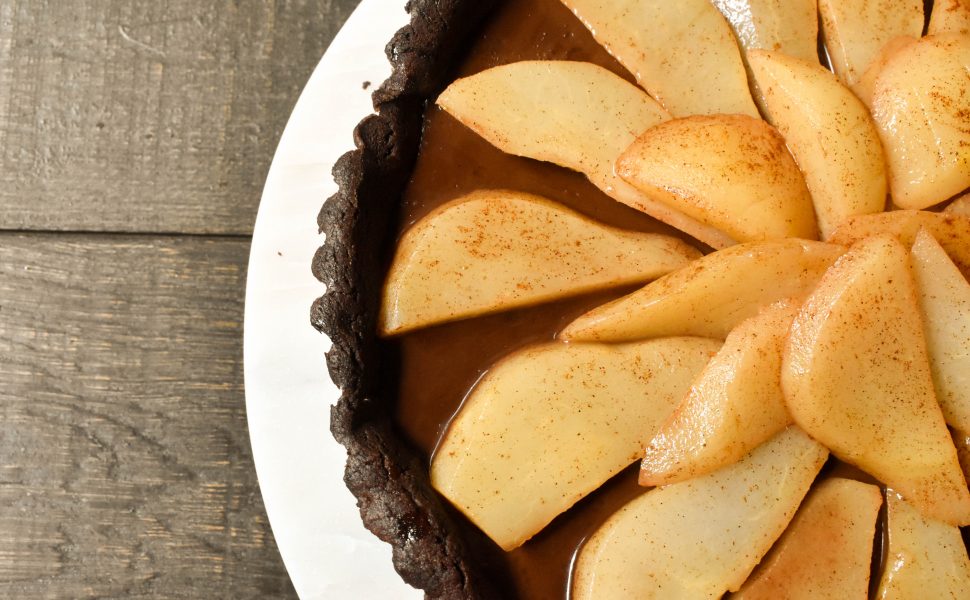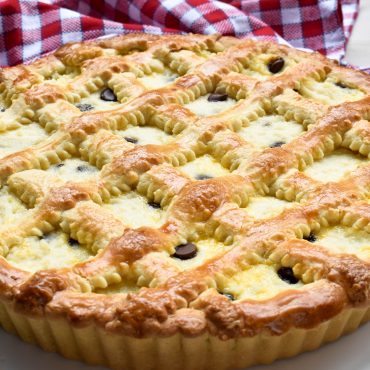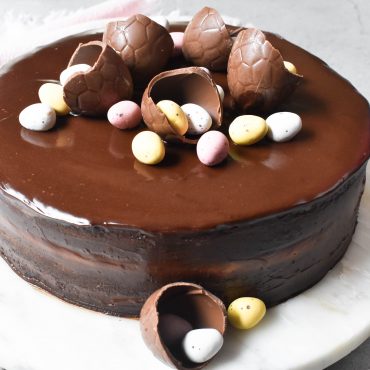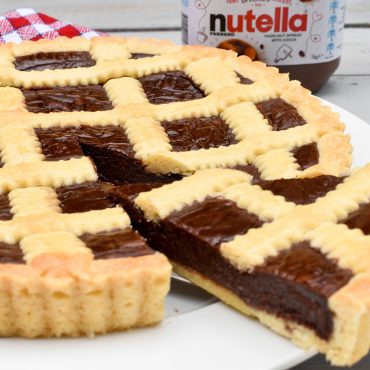Chocolate and pear tart
- 165g unsalted butter (cold from the fridge if using food processor – see tip in step 1)
- 280g 00 flour – refer to note in step 2
- 45g good quality unsweetened cocoa powder (cacao magro)
- 100g castor sugar
- 1 whole egg + 1 egg yolk
- 1/2 teaspoon baking powder
- Icing (confectioners’) sugar, for dusting work surface and rolling pin
- 1 pinch salt
- 2 pears, peeled, halved, cored
- 250ml water
- 2 teaspoons sugar
- 1 teaspoon cinnamon
- 200g good quality dark chocolate, roughly chopped
- 300ml thickened cream
- 20g unsalted butter, cut into small cubes
Requires: 24cm round, loose-bottom metal tart tin (base-measurement), rolling pin, baking beads or rice (to blind-bake) and a whisk
In a food processor (with the metal blade inserted): Process the butter, flour, cocoa powder and salt until the texture resembles fine breadcrumbs. Add the castor sugar, eggs (1 whole and 1 egg yolk) and baking powder. Mix until the dough just starts to come together.
Alternatively, by hand: Combine the butter, flour, cocoa powder and salt in a bowl. Use your fingertips to rub the butter into the flour until the texture resembles fine breadcrumbs. Add the castor sugar, eggs (1 whole and 1 egg yolk) and baking powder. Mix by hand until the dough just starts to come together.
Note: 00 is a powder-fine Italian type of flour. It is made from soft wheat varieties, and is frequently used in Italian desserts and pastas. 00 flour is available in most supermarkets, Italian food stores and gourmet delicatessens.
Turn the pastry onto a clean work surface and lightly knead to bring together. Gather the dough with your hands to form a ball. Wrap in plastic wrap (cling film) and refrigerate for 30 minutes.
Meanwhile, preheat the oven to 180°C conventional oven/ 160°C fan-forced (356° F/Gas 4).
Cut the pears lengthways into approximately 8mm-thick slices. Place the pears into a saucepan. Add the water, sugar and cinnamon. Cook over medium heat to bring to the boil. Reduce the heat to low and cook for a further 5 minutes or until the pears are almost tender. Drain the pears of the cooking liquid and place individual slices on a cooling rack to drain completely.
Lightly sprinkle the work surface with icing (confectioners’) sugar. Turn the sweet pastry dough onto the icing sugar. Use a rolling pin to roll out the dough. It should be large enough to fit the base and sides of the 24cm round, loose-bottom metal tart tin. If the pastry is sticking to the work surface, roll dough onto baking paper. Rub icing (confectioners’) sugar over the rolling pin and gently roll up the sweet pastry dough around the rolling pin. Unroll the sweet pastry dough into the metal tart tin. Trim the edge by running the rolling pin across the top of the tin, then gently push the pastry a little above the edge of the tin. Use a fork to prick the base all over.
Line the top of the pastry with baking paper. Fill the tart tin with baking beads or rice. Place the tart tin on top of a shallow baking tray. Blind-bake for 12 minutes then remove from the oven.
Carefully remove the baking beads or rice. Bake for a further 12-15 minutes or until the pastry is cooked through. Set aside to cool to room temperature.
To make the Chocolate filling, place the chocolate into a small heatproof bowl (or small saucepan) over a saucepan containing hot water to reach a depth of approximately 5cm. Heat over low heat to make a ‘Bain Marie’ (water bath). Stir the chocolate using a metal spoon until melted. To make the Chocolate filling, place the chocolate into a small heatproof bowl (or small saucepan) over a saucepan containing hot water to reach a depth of approximately 5cm. Heat over low heat to make a ‘Bain Marie’ (water bath). Stir the chocolate using a metal spoon until melted.
Add the cream to the bowl/saucepan with chocolate and whisk over low heat for 2 minutes or until combined. Whisk in the butter until smooth and combined. Remove from the heat. Set the Chocolate filling aside to cool for 15 minutes, stirring from time to time.
Pour the Chocolate tart filling on top of the sweet pastry in the base of the metal tart tin. Refrigerate for 4 hours to set.
Remove from the fridge. Arrange the pear slices in a circular pattern, starting from the outside and working inward to completely cover the chocolate tart before serving – Buon appetito.




